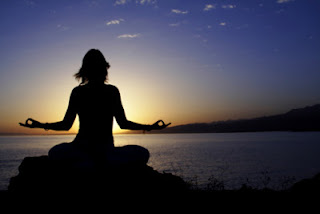By Jenny Park
Yoga has grown increasingly popular in recent years for the
benefits it brings people, both in physical as well as in spiritual ways. While
many people practice yoga on a weekly or even daily basis for exercise or just to
get a chance to relax in the midst of our busy, fast-paced modern world, more
and more people are turning to yoga for another reason: yogic therapy has been
shown to be successful in managing and coping with devastating and emotionally
taxing diseases.
Multiple sclerosis, or MS, is a debilitating and degenerative
disease of the nervous system. MS patients exhibit a wide array of symptoms,
both physical and psychological. Treating MS with yoga therapy has yielded
encouraging results. Though by no means can yoga cure MS patients, but it can make
many things about the disease easier to bear.
MS patients commonly report fatigue and decreased levels of
energy. In 2004, at the Oregon Health and Science University, a randomized and
controlled study of the effects of yogic therapy on 69 MS patients demonstrated
that there was a significant increase in patients’ reported energy and a
corresponding decrease in fatigue. Many MS patients consider fatigue to be one
of the most difficult symptoms of the disease.
Another symptom MS patients struggle with is chronic pain.
Various studies have shown that yoga training can dramatically increase its
practitioners’ ability to manage pain. Chronic pain sufferers from some
studies, including one performed by researchers at Boston University School of
Medicine in 2009, report reduction of chronic pain while using yogic
methodologies by as much as one-third, with use of pain medication decreasing
by as much as eighty percent.
Research is also showing that yoga exercise may have greater ability than
other forms of exercise to raise the brain’s GABA levels. GABA, or gamma-amino
butyric acid, is closely connected to muscle tone, something many people are
seeking to improve when they choose yoga as their exercise regimen. But GABA is
also crucial to enabling the brain to regulate such things as mood, stress and
anxiety. Low GABA levels are associated with depression and other mental
disorders, especially anxiety disorders. Since MS patients regularly suffer
from depression and other psychological problems, yogic therapy is highly
recommended for the benefits it confers in this area.
In short, many factors that affect the overall quality of life
for multiple sclerosis patients can be greatly relieved by the practice of
yoga.
Asanas for MS
As teachers, we have all learned by now that yoga really 'does a body good.'
Most people believe that all asanas and the pranayama practice can only benefit those who are already in perfect health, who are completely mobile, and who are model quality women in their early 20s, but that is far
from the truth. Those who face challenges with multiple sclerosis or MS, for
instance, can improve their quality of life in a major way.
Firstly, guidance from an educated and certified yoga teacher or therapist is essential. MS patients will be able to take some techniques home, but some of these techniques require preparation, modification, adjustment and guidance. Working with MS patients is not for the boot camp minded drill sergeant instructor. Working with people who have special needs requires knowing more than 24 postures and barking at your students like a crazed parrot.
There are asanas for MS. Experts say that with the right kind of
guidance, moderate and severe symptoms can be managed. Multiple sclerosis is a
disease that attacks the nervous system, causing numbness, problems with
balance and even paralysis. Yogic practices focus on stretching, breathing and
connecting the body, mind and spirit as one. MS students who perform special
asanas gradually improve balance, flexibility, and fatigue and stress levels.
The National Multiple Sclerosis Society gives the thumbs up to
yoga for MS, stating that the student will reap important benefits from a
routine of special asanas. The organization advises the student choose the
right class, teacher or video for proper instruction. As with any exercise
program, NMSS suggests the student check with his or her physician first.
Classes that concentrate on asanas for those with MS offer
instruction to all ability levels. The poses are modified for safety whether
seated or standing. Props such as chairs, straps or blankets are used for
comfort and to eliminate joint stress.
The Paschimottanasana or seated forward bend is an excellent
asana for stretching the spine and calves and relaxing the neck and shoulders.
The asana also betters one's concentration and invigorates the nervous system.
The Viparita Dandasana or chair-supported back bend is another
wonderful way to receive the benefits of yogic practices. The inverted pose
increases lung capacity and calms one down. It also strengthens the heart and
relieves lower back discomfort.
The Chakrasana or the wheel is an incredible pose and
challenging to most students. With the correct guidance of a therapist or therapeutic yoga teacher, someone with MS could
benefit considerably doing the pose. This raised bow posture encourages
suppleness of the spine while stimulating the cardiovascular system and
reducing fatigue.
I know - your saying, "How can I pull that off." Paul taught me you can do anything with props, but picture this: You need a cylinder shape below the spine. Your options are bolsters, pillows, blankets, a stability ball with legs or the peanut stability ball.
Janu Sirsasana or head-to-knee forward bend relieves
anxiety, fatigue and headache. The posture also stretches the spine, shoulders,
hamstrings and groin. The asana is also said to be good for improving indigestion, high
blood pressure and insomnia.
© Copyright 2013 – Aura Wellness Center – Publications Division
Do you want to know how to become a certified yoga instructor? Read more about the proof of medical benefits from participating in yoga training sessions.


